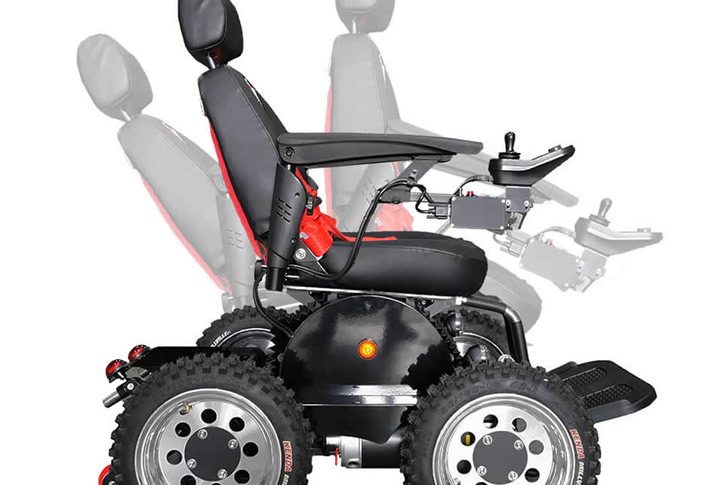Wheelchair Stair Climbers with Tracks: Everything You Need to Know About Its Features
Wheelchair stair climbers with tracks are innovative devices that enable wheelchair users to navigate stairs safely and independently. This article delves into their features, benefits, and important considerations, providing valuable insights for potential users and caregivers.

Introduction to Wheelchair Stair Climbers with Tracks
Wheelchair stair climbers with tracks are designed to offer a practical solution for individuals with mobility challenges, allowing them to move up and down stairs without needing to transfer out of their wheelchair. These devices are especially beneficial in environments where installing ramps or elevators is not feasible.
Key Features of Wheelchair Stair Climbers with Tracks
1. Track System
The primary feature distinguishing these stair climbers is the track system. Tracks provide stability and distribute weight evenly, allowing for a smooth and secure climb over stairs. These tracks are usually made of high-strength rubber or similar materials to ensure durability and grip.
- Stability: Tracks enhance stability compared to wheeled climbers, which can be less stable on stairs.
- Weight Distribution: Even weight distribution prevents damage to stairs and enhances user comfort.
2. Power Source
Most wheelchair stair climbers with tracks are powered by electric motors, which make the ascent and descent of stairs nearly effortless for both the user and the assistant. The electric motor is usually powered by rechargeable batteries.
- Battery Life: Typically, these batteries can last for multiple trips up and down stairs, depending on the model and weight of the user. For instance, a standard battery might last for about 20-30 floors on a single charge.
- Charging Time: Batteries usually take 4-6 hours to charge fully.
3. User Control Interface
These devices are equipped with a user-friendly control interface, often including a joystick or button controls, to manage movement and speed. Some models also offer remote control options for caregivers.
- Ease of Use: Controls are designed to be intuitive, allowing users or caregivers to operate the device with minimal training.
- Safety Features: Emergency stop buttons and automatic braking systems are commonly included to ensure user safety.
4. Safety Mechanisms
Safety is paramount when it comes to stair climbers. Therefore, these devices come with multiple safety features:
- Seat Belts and Harnesses: Ensure the user is securely fastened during operation.
- Anti-Tip Mechanisms: Prevent the device from tipping over on steep or uneven stairs.
- Obstacle Detection: Some advanced models include sensors that detect obstacles on the stairs and stop the device to prevent accidents.
5. Portability and Storage
While some stair climbers are designed to be permanently installed, many models are portable and can be folded for easy storage and transport.
- Weight: Portable models typically weigh between 20-30 kg (44-66 lbs), making them manageable for most caregivers.
- Foldability: The ability to fold and store the device in a car trunk or a closet adds to its convenience.
Benefits of Using Wheelchair Stair Climbers with Tracks
1. Increased Accessibility
Stair climbers significantly enhance accessibility in buildings without elevators or ramps, allowing wheelchair users to move freely and independently.
- Residential Use: Ideal for multi-story homes, enabling users to access all levels of their home.
- Public Buildings: Useful in public buildings, schools, and historical sites where structural modifications are restricted.
2. Enhanced Safety
The robust design and comprehensive safety features of track-based stair climbers minimize the risk of accidents, providing peace of mind for users and caregivers.
- Emergency Situations: Useful in emergencies where rapid evacuation is necessary, such as during a fire.
3. Cost-Effective Solution
Compared to installing elevators or extensive ramp systems, stair climbers are often more cost-effective, particularly in older buildings where modifications can be expensive and complex.
- Installation Costs: No permanent installation is required, saving on construction and maintenance costs.
- Long-Term Savings: Reduces the need for multiple caregivers to assist with stair navigation, leading to long-term savings on assistance costs.
Important Considerations When Choosing a Wheelchair Stair Climber with Tracks
1. Weight Capacity
Ensure the device can accommodate the user’s weight, including the weight of the wheelchair. Most models support weights between 120-200 kg (265-440 lbs).
2. Staircase Compatibility
Verify that the stair climber is compatible with the type and dimensions of the stairs in your home or building. Some devices may not work well with very narrow or spiral staircases.
- Step Height and Depth: Check the maximum step height and depth that the climber can handle.
- Surface Type: Ensure the tracks provide adequate grip on the material of your stairs, whether it’s carpet, wood, or tile.
3. Training and Support
Look for manufacturers that offer comprehensive training and support for users and caregivers. Proper training ensures safe and effective use of the device.
- User Manual and Videos: Check for detailed user manuals and instructional videos.
- Customer Support: Reliable customer support can assist with troubleshooting and maintenance.
Popular Models and Brands
Some popular models and brands known for their quality and reliability include:
- Scalacombi S34: Known for its ease of use and robust safety features.
- TopChair-S: Features advanced obstacle detection and high weight capacity.
- Liftkar PTR: Lightweight and highly portable, suitable for various staircase types.
Conclusion
Wheelchair stair climbers with tracks are transformative devices that enhance mobility and independence for wheelchair users. By understanding their key features, benefits, and important considerations, you can make an informed decision to find the best solution for your needs. Whether for residential or public use, these stair climbers provide a safe, cost-effective, and practical solution for navigating stairs.







Recent Comments